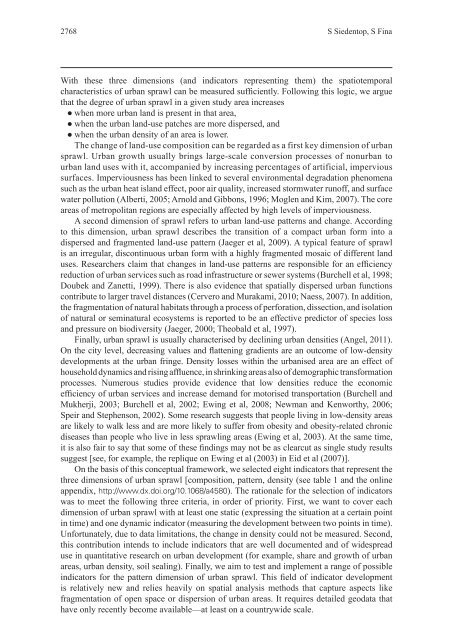PDF 20.134kB - TOBIAS-lib - Universität Tübingen
PDF 20.134kB - TOBIAS-lib - Universität Tübingen
PDF 20.134kB - TOBIAS-lib - Universität Tübingen
Erfolgreiche ePaper selbst erstellen
Machen Sie aus Ihren PDF Publikationen ein blätterbares Flipbook mit unserer einzigartigen Google optimierten e-Paper Software.
2768 S Siedentop, S Fina<br />
With these three dimensions (and indicators representing them) the spatiotemporal<br />
characteristics of urban sprawl can be measured suf ciently. Following this logic, we argue<br />
that the degree of urban sprawl in a given study area increases<br />
when more urban land is present in that area,<br />
when the urban land-use patches are more dispersed, and<br />
when the urban density of an area is lower.<br />
The change of land-use composition can be regarded as a first key dimension of urban<br />
sprawl. Urban growth usually brings large-scale conversion processes of nonurban to<br />
urban land uses with it, accompanied by increasing percentages of artificial, impervious<br />
surfaces. Imperviousness has been linked to several environmental degradation phenomena<br />
such as the urban heat island effect, poor air quality, increased stormwater runoff, and surface<br />
water pollution (Alberti, 2005; Arnold and Gibbons, 1996; Moglen and Kim, 2007). The core<br />
areas of metropolitan regions are especially affected by high levels of imperviousness.<br />
A second dimension of sprawl refers to urban land-use patterns and change. According<br />
to this dimension, urban sprawl describes the transition of a compact urban form into a<br />
dispersed and fragmented land-use pattern (Jaeger et al, 2009). A typical feature of sprawl<br />
is an irregular, discontinuous urban form with a highly fragmented mosaic of different land<br />
uses. Researchers claim that changes in land-use patterns are responsible for an ef ciency<br />
reduction of urban services such as road infrastructure or sewer systems (Burchell et al, 1998;<br />
Doubek and Zanetti, 1999). There is also evidence that spatially dispersed urban functions<br />
contribute to larger travel distances (Cervero and Murakami, 2010; Naess, 2007). In addition,<br />
the fragmentation of natural habitats through a process of perforation, dissection, and isolation<br />
of natural or seminatural ecosystems is reported to be an effective predictor of species loss<br />
and pressure on biodiversity (Jaeger, 2000; Theobald et al, 1997).<br />
Finally, urban sprawl is usually characterised by declining urban densities (Angel, 2011).<br />
On the city level, decreasing values and attening gradients are an outcome of low-density<br />
developments at the urban fringe. Density losses within the urbanised area are an effect of<br />
household dynamics and rising af uence, in shrinking areas also of demographic transformation<br />
processes. Numerous studies provide evidence that low densities reduce the economic<br />
ef ciency of urban services and increase demand for motorised transportation (Burchell and<br />
Mukherji, 2003; Burchell et al, 2002; Ewing et al, 2008; Newman and Kenworthy, 2006;<br />
Speir and Stephenson, 2002). Some research suggests that people living in low-density areas<br />
are likely to walk less and are more likely to suffer from obesity and obesity-related chronic<br />
diseases than people who live in less sprawling areas (Ewing et al, 2003). At the same time,<br />
it is also fair to say that some of these ndings may not be as clearcut as single study results<br />
suggest [see, for example, the replique on Ewing et al (2003) in Eid et al (2007)].<br />
On the basis of this conceptual framework, we selected eight indicators that represent the<br />
three dimensions of urban sprawl [composition, pattern, density (see table 1 and the online<br />
appendix, http://www.dx.doi.org/10.1068/a4580). The rationale for the selection of indicators<br />
was to meet the following three criteria, in order of priority. First, we want to cover each<br />
dimension of urban sprawl with at least one static (expressing the situation at a certain point<br />
in time) and one dynamic indicator (measuring the development between two points in time).<br />
Unfortunately, due to data limitations, the change in density could not be measured. Second,<br />
this contribution intends to include indicators that are well documented and of widespread<br />
use in quantitative research on urban development (for example, share and growth of urban<br />
areas, urban density, soil sealing). Finally, we aim to test and implement a range of possible<br />
indicators for the pattern dimension of urban sprawl. This eld of indicator development<br />
is relatively new and relies heavily on spatial analysis methods that capture aspects like<br />
fragmentation of open space or dispersion of urban areas. It requires detailed geodata that<br />
have only recently become available—at least on a countrywide scale.

















